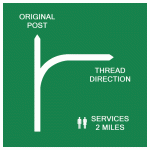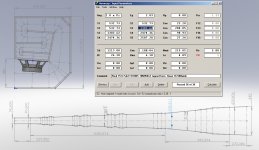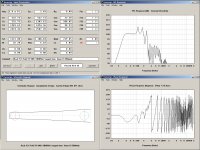Post 68 was drawn in Solidworks 2009. Using a parametric CAD system to sketch out the TH has the advantage that the schematic sketch updates as I manipulate the TH model. I am confident that the dimensions of this model & sim are accurate & honest.What programs are you two using in posts 68, 72 & 73?
Most 15" drivers are limited by excursion in a TH. A large x-max is needed to get anywhere near the rated power. I have a pair of Fane XB 15" 800W AES drivers but with a 7.5mm x-max, hornresp suggests that about 250W is their limit.According to hornresp my THAM15 design would be pretty useless above 500W of input power, however, real world users claim they seem to handle almost twice that without any serious/notable compromise in preformance
Hopefully this should mean that this design is very reliable and dynamic.
The quoted power compression for the Precision Devices PD1850 is 1.6db at rated power (800W AES). This is probably due to the 5" voice coil!Everyone just forgets to factor in power compression, and other things that come into effect at the ends of a drivers throw
Practical experience has shown the PD1850 to be a very robust and loud horn driver. I would of thought that 1000w per driver would be OK. Most 15" drivers would be beyond x-max and severely into power compression at these levels.
with a circular saw,cut in half thicknes ,number is dependend on radius,What programs are you two using in posts 68, 72 & 73?
@ epa: how would those curved bottom pieces in post 73 be made?
fil de cuts with glue (the brown stuf)bring in position .when its dry it wil stay that way.
if you decide to bild it i wil give details how to cut it
P.S. if there's a way to only add 3 to Le instead of 4. I like the amount of output for it's small size. A definite plus!
you can ad anything up to 5 mh
i agree. no need to put that much stress on a speaker anyway.Everyone just forgets to factor in power compression, and other things that come into effect at the ends of a drivers throw.
Once you get to ~500w with a majority of drivers, it is not unheard of to be 2-4dB down already, so it is easy to see how you can throw 2-3x the power expected into an enclosure, and not have it grenade on you from over excursion. Assuming a HP is in place of course.
The best way to get around this is to not count on having the last 3-6dB of sim output. If you need 130dB at 1m, you need the speakers to sim around 133-136dB.
if one need that much output,better weel in an extra cab.
make's your f3 a bit lower as wel
also the huge magnet on the pd keeps things cool..
Hopefully this should mean that this design is very reliable and dynamic.
The quoted power compression for the Precision Devices PD1850 is 1.6db at rated power (800W AES). This is probably due to the 5" voice coil!
Practical experience has shown the PD1850 to be a very robust and loud horn driver. I would of thought that 1000w per driver would be OK. Most 15" drivers would be beyond x-max and severely into power compression at these levels.
still i dont like to put that much stress on a speaker.
altough its nice to know that its possible.but use it for headroom instead of continues power
my 2 cents
i use autocad for the drawingsWhat programs are you two using in posts 68, 72 & 73?
I think we are looking at more of a theoretical problem then a real world problem when it comes to excursion, even if the simulations show that excusrion limmiting will occour at so and so many watts at this or that frequency, the real world experience might be different, most often to the better.
According to hornresp my THAM15 design would be pretty useless above 500W of input power, however, real world users claim they seem to handle almost twice that without any serious/notable compromise in preformance, and I'm sure this is true for most TH designs.
As for the simulations I'm sure they are correct from a purly mathematical point of wiev, hornresp is probably the best thing that has happened to us, it really is a wonderful tool and the creator of this software deserves all of our gratitude, but, there is a differance between the theory and real life usage senarios.
I just think it is important to recognize this and bare it in mind when we look at these designs, I'm sure they will preform excellent in a real life envionment where, as allways, careful and signal processing should be applied.
The "does it really run out of Xmax?" issue is true for many kinds of music, you can see this from the power levels routinely used with Danley tapped horns, but dubstep -- which Crescendo said is what he plays -- is one of the exceptions, it can have long synthesised dropping bass notes which are pretty much sinewaves at close to full power which sweep through the maximum excursion frequency.
If you want to be able to cope with this then you need lots of Xmax, like the BMS15N850 can provide. If you don't, drivers like the RCF will be fine.
Horses for courses
15" tapped horn with RCF...hummm...
LOL! Completely agreed. Just shy of thread-jacking. Good thing the OG poster was thru with the thread. We should've made a new thread, nonetheless.
Exactlyhi-jacked in a good way. Xoc1 design is based on Woody1, the thread starter.

I would of not posted unless I thought it was relevant
Just so we are all on the same page... every note ever played and all music is made up of fundamentals and overtones. otherwise known as sinewaves.
Obviously, but with most non-synthesised instruments (like electric bass) the harmonics have at least as much power as the fundamental, so even if you play a low C on a 5 string bass at 32Hz the power at 32Hz isn't as high as some synthesized bass notes at the same frequency, because there's considerable power at 64Hz, 94Hz and so on.
So in this case you will never hit the Xmax predicted by Hornresp for a full-power sinewave -- for example the 15TBX100 in the Danley TH-115 will run out of Xmax at around 600W on sinewaves, but the driver is rated at 1000W and a 2000W amp is recommended for music applications.
Some people would say dubstep *isn't* music so this doesn't apply ;-)
Epa: In electronic dance music, the low bass, for example the kickdrum or rather its fundamental, is often used as a sidechain input for a compressor for the rest of the music (thats where the pumping effect comes from). Which means, that everything else is turned down when the bass hits, so that the bass is only about 3-6db lower than the theoretical maximum loudness. This isnt as extreme in normal pop music and there is little difference between dubstep, techno or electro and what else you can get. Bottom line: The type of music has quite the influence on how far you can turn up the volume.
Looking at the waveform doenst help you much. Get a spectral monitor like Voxengo Span, activate Peak hold and check the volume of the partials.
Looking at the waveform doenst help you much. Get a spectral monitor like Voxengo Span, activate Peak hold and check the volume of the partials.
thanks mavo.
the discusion imo is about continius lf base notes wich would fry the voice coil if its on the excursion minimum at high levels.
its not about peaks.
my point is that there are never only sine waves happening in music,there are always some harmonics and other sounds present.
the sample is taken from a part in the music were there is no base drum, only snare and high hat and synth.
not saying is wat you say isnt right.
as a side note ,ive done live music PA and i only put compression over the mics and over the end mix with a high treshhold,as i like to keep as much dynamics as possible
the discusion imo is about continius lf base notes wich would fry the voice coil if its on the excursion minimum at high levels.
its not about peaks.
my point is that there are never only sine waves happening in music,there are always some harmonics and other sounds present.
the sample is taken from a part in the music were there is no base drum, only snare and high hat and synth.
not saying is wat you say isnt right.
as a side note ,ive done live music PA and i only put compression over the mics and over the end mix with a high treshhold,as i like to keep as much dynamics as possible
Last edited:
This is another modded 6 fold Xoc1 box using the BMS 18N850v2... I just don't know how to sketch it up yet :/ Anyone up to the task til I learn? I know this will be bigger, but I don't think by too much.




This would be near ideal without getting to 600 liters (which I can get flat to 30Hz @ 130dB).
My next favorite is post 73, as it plays ~4-5dB louder at 30Hz and stays flat (which I need) than post 68.
Thanks a ton, everyone!
Justin




This would be near ideal without getting to 600 liters (which I can get flat to 30Hz @ 130dB).
My next favorite is post 73, as it plays ~4-5dB louder at 30Hz and stays flat (which I need) than post 68.
Thanks a ton, everyone!
Justin
Last edited:
please help i need to know what pant did you use. i did not find Warnex textured lacquer please break it down for me.
Crescendo
I have remodelled the 6 fold TH to something similar to what you posted.
If you look you will see that efficiency is slightly more than your sim.
I shifted the point where the taper changes back one fold in the box. This makes the geometry more complicated.
If I was you I would probably forget about adding an inductor to try to flatten the theoretical response. Especially at the power levels that you are attempting.
I have remodelled the 6 fold TH to something similar to what you posted.
If you look you will see that efficiency is slightly more than your sim.
I shifted the point where the taper changes back one fold in the box. This makes the geometry more complicated.
If I was you I would probably forget about adding an inductor to try to flatten the theoretical response. Especially at the power levels that you are attempting.
Attachments
Crescendo
I have remodelled the 6 fold TH to something similar to what you posted.
If you look you will see that efficiency is slightly more than your sim.
I shifted the point where the taper changes back one fold in the box. This makes the geometry more complicated.
If I was you I would probably forget about adding an inductor to try to flatten the theoretical response. Especially at the power levels that you are attempting.
but then again ,pick any 2 of small ,low and loud
this one would be

2 cressendo have you seen post 90 ?
Last edited:
this would prbably be ~650 ltrsThis is another modded 6 fold Xoc1 box using the BMS 18N850v2... I just don't know how to sketch it up yet :/ Anyone up to the task til I learn? I know this will be bigger, but I don't think by too much.
This would be near ideal without getting to 600 liters (which I can get flat to 30Hz @ 130dB).
My next favorite is post 73, as it plays ~4-5dB louder at 30Hz and stays flat (which I need) than post 68.
Thanks a ton, everyone!
Justin
the actual box wil always be bigger than the schematic diagram predicts,because material and corners hr doesn't calculate.!
best way to learn sketching ,is just to do it.
i use autocad but it took me quite a wile before i got the hang of it.
im sure there are easier programs around wich u can use.
Last edited:
- Status
- This old topic is closed. If you want to reopen this topic, contact a moderator using the "Report Post" button.
- Home
- Loudspeakers
- Subwoofers
- 15" tapped horn with RCF




